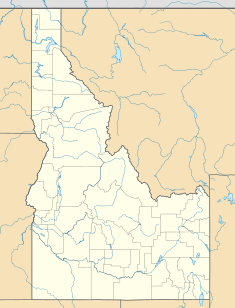Boise River Diversion Dam facts for kids
Quick facts for kids Boise River Diversion Dam |
|
|---|---|
 |
|
|
Location of Boise River Diversion Dam in Idaho
|
|
| Country | United States |
| Location | Ada County, Idaho |
| Coordinates | 43°32′15″N 116°05′36″W / 43.53750°N 116.09333°W |
| Status | Operational |
| Construction began | 1906 |
| Opening date | 1909 |
| Owner(s) | USBR |
| Dam and spillways | |
| Impounds | Boise River |
| Height | 68 ft (21 m) |
| Length | 500 ft (152 m) |
| Elevation at crest | 2,829 ft (862 m) |
| Width (crest) | 12 ft (4 m) |
| Width (base) | 100 ft (30 m) |
| Spillway capacity | 37,700 cu ft/s (1,068 m3/s) |
| Reservoir | |
| Creates | 1,200 acre⋅ft (1,480,178 m3) |
| Power station | |
| Commission date | 1912 |
| Turbines | 3 x Francis turbines |
| Installed capacity | 3.45 MW |
The Boise River Diversion Dam is a special dam in Idaho, United States. It's located about 7 miles (11 km) southeast of the city of Boise in Ada County. This dam was finished in 1909. It is managed by the U.S. Bureau of Reclamation. The dam's main job is to send water from the Boise River into a large concrete channel called the New York Canal. This canal is super important for irrigation, providing water to farms in Ada and Canyon counties.
Building the Dam
Work on the Boise River Diversion Dam started in March 1906. The company building it, Utah Fire Proofing Company, was supposed to finish in one year. But they faced many challenges. They didn't have enough experienced leaders for the project. Many different supervisors worked on the dam, which caused a lot of workers to leave.
Bad weather and floods also caused delays. Crews even had to rebuild parts of the dam. By April 1907, only 41% of the dam was complete. It took another year and a half before the dam was ready to send water into the New York Canal. Even with all these problems, once the dam was finished, it worked very well! The Diversion Dam is 68 feet (21 meters) high and 500 feet (152 meters) long.
Powerhouse History
A small power plant was added to the Diversion Dam in 1912. This was done to create electricity for building the Arrowrock Dam upstream. The plant's three generators made 1,500 kilowatts of power. This electricity helped run the construction camp, sawmills, and giant cement mixers at Arrowrock.
The turbines used in the plant were special. They were the first in the world to be built with a vertical shaft design. Along with power lines, a phone cable was also installed. This connected Arrowrock Dam to the outside world.
In 1976, the power plant was added to the National Register of Historic Places. This means it's an important historical site. It was updated in 2002 and now serves as a backup power source. It can provide extra electricity when needed. Special care was taken to keep the powerhouse looking historic. Many original parts, like the control panels and generators, were kept for their historical value, even if they don't work anymore.
- Historic American Engineering Record (HAER) No. ID-17-A, "Boise Project, Boise River Diversion Dam, Across Boise River, Boise vicinity, Ada County, ID"



